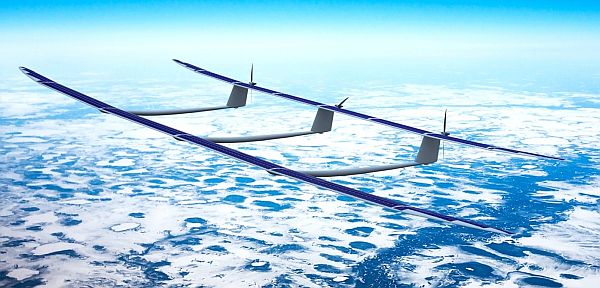Podcast: Play in new window | Download (Duration: 29:22 — 20.2MB)
A pseudo satellite drone with deformable wings, an agricultural drone that sprays crops, a project for drone applications in cities, the FAA makes a Federal preemption statement, a payment concept for drone package delivery, and a deformable drone that absorbs impacts.
UAV News
Prototype Solar-Powered, High-Altitude UAV Undergoing Flight Tests
The UAVOS Inc. HAPS (High Altitude Pseudo Satellite) aircraft is solar-powered with a flexible wing for control. The ApusDuo prototype has been flown more than 1000 hours at altitudes of up to 65,617 feet (20,000 meters). Flight tests confirmed the aircraft can handle turbulence by actively changing the bend of the wing. UAVOS specializes in the design, development, and manufacturing of unmanned vehicles and autopilot systems and components. Their solutions range from small industrial surveillance drones to large UAVs.
North Dakota State University’s Herbicide-Spraying Drone Covers 33 Acres in an Hour
The University’s Agricultural and Biosystems Engineering department is using an AG V6+ agriculture drone from Homeland Surveillance & Electronics. It holds four gallons of herbicide and flies autonomously for 30 minutes, covering 33 acres in one hour. The department’s “smart farm” project looks to deploy the drone in precise areas of land and fly autonomously without the need for a high-resolution imaging drone.
Promotional video: AG v6a+ UAV Crop Sprayer
Report: UK has golden opportunity to shape future of drones
The Nesta innovation foundation conducted the Flying High Challenge pilot project to investigate applications for drones in cities. The objectives of the Challenge were to shape plans for the future of drones in UK cities, identify and address key complexities, and detail technical and economic plans. The project collaborated with five cities to analyze socially beneficial use cases. See the final report: Flying High: The future of drone technology in UK cities
FAA Clarifies Federal Authority Over Drone Rulemaking
Some state and local governments have passed laws that regulate drones, but who has authority over the airspace? In Press Release – FAA Statement–Federal vs. Local Drone Authority, the FAA says, “Congress has provided the FAA with exclusive authority to regulate aviation safety, the efficiency of the navigable airspace, and air traffic control, among other things. State and local governments are not permitted to regulate any type of aircraft operations, such as flight paths or altitudes, or the navigable airspace.” But local governments can control landing sites through their land use powers.
Worldpay’s Drone Delivery Mat Identifies Customer Before Releasing Package
While many companies are developing package delivery systems, Worldpay is thinking about the payment system: how the customer ensures they receive the package and how the seller ensures they get paid? Worldpay’s idea is that customers get a portable landing pad tied to their credit card, the delivery drone lands on the pad, and the drone confirms the delivery location is correct. Then payment is authorized and the package is released. Worldpay’s Drone Pay proof-of-concept uses EMV contactless payment card technology embedded into the drone landing pad.
Demonstration video: Drone Pay by Worldpay
https://youtu.be/YR9s_lp9l30
An insect-inspired drone deforms upon impact
Researchers at the Swiss Federal Institute of Technology Lausanne (EPFL) developed a drone that deforms on impact. The design is inspired by insect wings and also by origami. The hybrid origami drone can be stiff or flexible depending on the circumstances. The structure is stiff when airborne but if the drone runs into something, it becomes flexible and absorbs the shock.
Video: An insect-inspired drone deforms upon impact
Mentioned
Webinar Invitation by the UAVs for Payload Delivery Working Group
August 1, 2018, 10am Eastern (GMT-4)
The newly developed Unmanned Aerial Vehicle Procurement Guide will be shared by the USAID Global Health Supply Chain Program – Procurement and Supply Management (GHSC-PSM) project. The guide’s purpose is to share lessons and insight from the project’s experience to help other organizations undertaking similar efforts. The guide will prevent them from reinventing the wheel or starting from zero to expedite the rate at which this technology is applied and scaled up. This webinar is open to anyone to attend.

